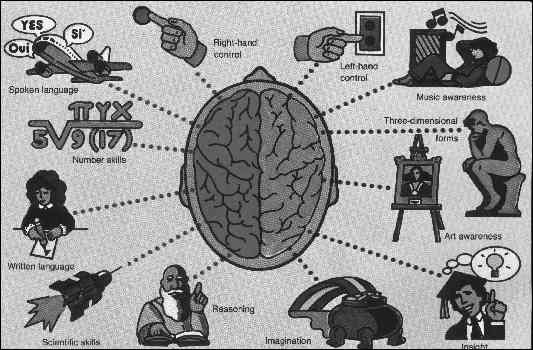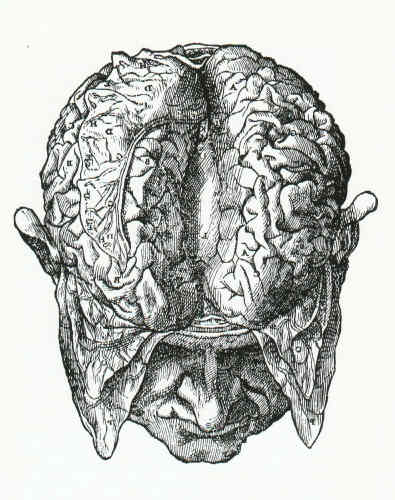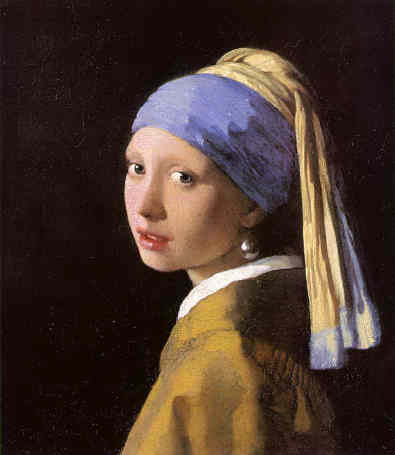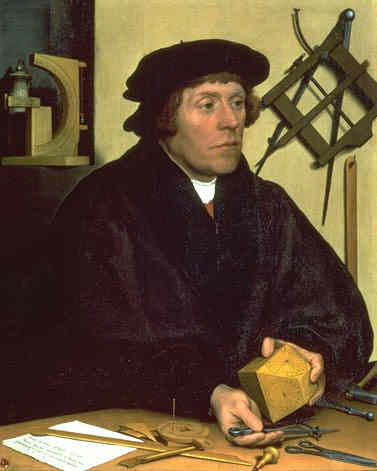![[Quick Reference Dictionary of Art]](booksml.gif)
QRDA
DISCUSSION #2
Susan Holden,
Instructor,
The Art Institute of Dallas

The left and the right hemisphere of the brain are joined by a large cable of nerve fibers called the
corpus callosum.
ILLUSTRATION OF BRAIN FROM VESALIUS FABRICA
These nerve fiberstransmit information back and forth between the two hemispheres. These two hemispheres then, are obviously designed to work together. Effectively accomplishing any given task, whatever the profession, requires the collaboration of both hemispheres.
Melba Benson, Phd., at the University of Texas in Arlington, Texas, is surveying and testing people in a variety of professions. She is finding that, no matter what the job function, there appears to be a relatively consistent balance between right and left mode reliance. This includes the "creative" professions, i.e., designers, graphic artists, fine artists, architects, animators, illustrators, etc. However (as one might imagine), the degree and the quality of the right hemisphere’s contribution is decidedly more critical in "creative" professions than in "non-creative" professions. The "creative" professional’s right sphere must be more highly developed...more highly "sensitized".
THE EYES HAVE IT

We all have eyes with which to see (exceptions noted). Exactly how we see and what sight is, has long been a subject of speculation and mystery throughout the history of man. Strange, exotic and magical things have been attributed to the eyes and the power of vision, from the ancient concept of the "Evil Eye", to the eyes being "the windows of the soul".
During the Middle Ages the popular belief was, that sight was some how the result of "visual rays" mysteriously emanating from the eyes.

MEDUSA by CARRAVAGIO
NOTE: Greek mythology contains a story about a woman called Medusa, who was half snake, half woman. It was said she could turn a man to stone with one glance from her "evil eyes".
This "visual ray" theory wasn’t new. It was first formally stated by the Greek philosopher, Empedocles and a generation later modified by Plato.
It was none other than the Renaissance Man himself, Leonardo Da Vinci , who finally set us on the right visual track. His empirical observations and consequent conclusions diametrically opposed the Platonian theory of "visual rays". Leonardo proclaimed that light entered the eye from the outside environment.
He further deduced, that the eye operated like a miniature
camera obscura. Although Mr. Vinci made many mistakes in his studies of the eye and its optics, these particular insights ultimately proved to be essentially correct.
Subsequent discoveries by other scholars, scientist, writers, philosophers, mathematicians and astronomers who followed Leonardo; i.e., Johannes Kepler , Issac Newton , Christiaan Huygens , Thomas Young and Herman von Helmholtz (to name a few), laid the scientific foundation for our present understanding of how we see.

![[Continue Natural Facilities Next Page]](buttoncontinue.gif)
![[Return to Discussion Topics]](buttondrwgtopics.gif)
![[TO NAVIGATION AID]](buttonnav.gif)
![[RETURN TO HOME PAGE]](buttonhomepage.gif)